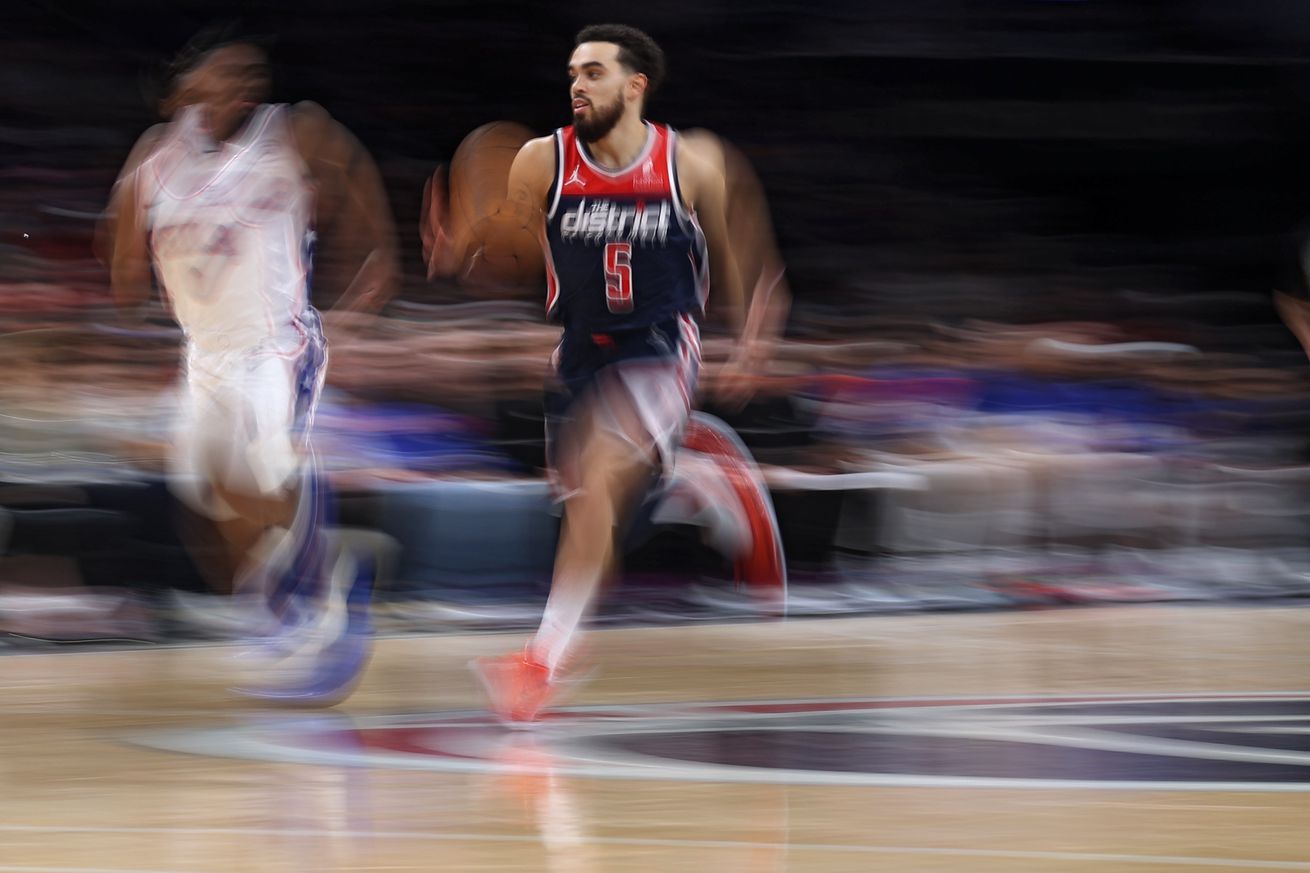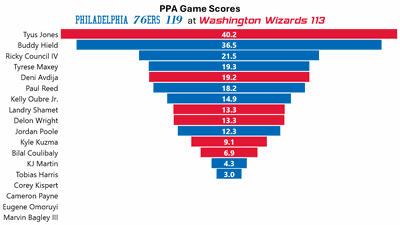
Stats, analysis, commentary.
The Wizards outshot the visiting Philadelphia 76ers, but lost the game because of turnovers and the inability to grab defensive rebounds.
Philly finishing the night +6 on the offensive glass and +4 in turnovers got them the extra shots they needed to squeeze out a six-point win despite missing Joel Embiid, De’Anthony Melton, and Nicolas Batum. That’s three starters, including the clubhouse leader for NBA Most Valuable Player until the knee injury.
The Washington offense shot decently (58.2% effective field goal percentage) but squandered the advantage good shooting usually provides with sloppy turnovers. Still, they battled on defense and mounted a late comeback after falling behind by 15 in the third quarter and looking like they were cooked.
It wasn’t enough to stave off their sixth consecutive defeat and 43rd loss of the season. The schedule ahead is brutal. They’re massive underdogs in each of their next 10 games. The next time they’re favored to win, according to my prediction machine, is March 8 against the Charlotte Hornets.
This & That
- The outlines for an effective Deni Avdija game were all in place. He defended, attacked the paint repeatedly, grabbed rebounds, pushed the ball in transition, and set up teammates for good shots. The next step: clean up the turnovers. He had five last night — a mix of an over-aggressive drive and some bad passes. Those miscues, accounting for 26.6% of his possession usage (average is 12.1% this season), cratered his offensive efficiency to -11 points per 100 possessions despite excellent shooting from the field (67.9% efg).
- Tyus Jones had another hyper-efficient offensive game — 25 points on 14 shots, 9 assists, 1 turnover. He hit a career high six threes (on just eight attempts).
- Kyle Kuzma ended up playing a lot as a sort of center for the Wizards with Daniel Gafford traded to the Dallas Mavericks and Marvin Bagley III playing ineptly. Defensively, Kuzma was okay — he had four blocks despite repeatedly missing rotations. On one, he was in help position but failed to notice Philly’s Cam Payne driving to the basket until Payne was already past him. Kuzma’s overall game was unimpressive — solid shooting offset by four turnovers and five fouls.
- Jordan Poole was kinda okay. He scored 11 points on eight shots, had 4 rebounds, 4 assists, 2 steals in 29 minutes. He also had two turnovers and four fouls. At least he wasn’t in negative PPA territory, where he’s been in more than a third of his games this season.
- Bilal Coulibaly was pretty meh, but it was at least an active, trying-to-make-plays kind of meh. Bright side: 10 free throw attempts and three offensive rebounds in 30 minutes. Down side: three turnovers.
- After being en fuego the previous night, Corey Kispert air-balled his first two three-point attempts en route to a crummy night.
- Eugene Omoruyi plays hard but is not a solution as a reserve center.
- Kudos to Ricky Council IV for the best game of his young career for the Sixers — 19 points, 10 rebounds, and some plays at the end to help secure the win.
- Tyrese Maxey is really good. I’m hoping Embiid is back in time for Philly to be at full strength entering the playoffs. I want to see some epic postseason battles.
Four Factors
Below are the four factors that decide wins and losses in basketball — shooting (efg), rebounding (offensive rebounds), ball handling (turnovers), fouling (free throws made).
Stats & Metrics
Below are a few performance metrics, including the Player Production Average (PPA) Game Score. PPA is my overall production metric, which credits players for things they do that help a team win (scoring, rebounding, playmaking, defending) and dings them for things that hurt (missed shots, turnovers, bad defense, fouls).
Game Score (GmSC) converts individual production into points on the scoreboard. The scale is the same as points and reflects each player’s total contributions for the game. The lowest possible GmSC is zero.
PPA is a per possession metric designed for larger data sets. In small sample sizes, the numbers can get weird. In PPA, 100 is average, higher is better and replacement level is 45. For a single game, replacement level isn’t much use, and I reiterate the caution about small samples sometimes producing weird results.
POSS is the number of possessions each player was on the floor in this game.
ORTG = offensive rating, which is points produced per individual possessions x 100. League average last season was 114.8. Points produced is not the same as points scored. It includes the value of assists and offensive rebounds, as well as sharing credit when receiving an assist.
USG = offensive usage rate. Average is 20%.
ORTG and USG are versions of stats created by former Wizards assistant coach Dean Oliver and modified by me. ORTG is an efficiency measure that accounts for the value of shooting, offensive rebounds, assists and turnovers. USG includes shooting from the floor and free throw line, offensive rebounds, assists and turnovers.
+PTS = “Plus Points” is a measure of the points gained or lost by each player based on their efficiency in this game compared to league average efficiency on the same number of possessions. A player with an offensive rating (points produced per possession x 100) of 100 who uses 20 possessions would produce 20 points. If the league average efficiency is 114, the league — on average — would produced 22.8 points in the same 20 possessions. So, the player in this hypothetical would have a +PTS score of -2.8.

